Amidst the growing global focus on sustainability, countries worldwide are prioritising policies to curb the volume of waste destined for landfills, which poses significant environmental threats. Rapid changes in lifestyles and technological advancements have led to a lack of effective waste disposal methods, exacerbating the challenge, particularly in the textile and fashion industry—a sector known for its dynamism but also for its substantial waste generation and environmental impact.
A notable disparity exists between producer and consumer countries regarding policies and innovations aimed at addressing textile and fashion waste. Nevertheless, it’s essential to recognise the collective efforts undertaken by the global textile industry to confront this pressing issue.
One must revisit the promises made during the most famous Copenhagen summit where many brands participate. Every year the summit raises awareness of the harm the industry is doing to the environment, but the 2017 summit saw significant commitments made by the industry towards innovation for sustainable textiles. The commitments included:
-
To effectuate the system of circularity
-
Augment the number of garments collected.
-
Increase the number of garments re-sold.
-
Increase the number of garments made from recycled post-consumer textile waste.
However, the commitments made 7 years ago didn’t bear fruit. As of today, there is only 1 per cent of textile waste recycled globally. All the remaining textile waste is dumped into the landfill. To make the problems worse, the issue is spreading on a global level to countries like Africa and Asia.
What Do the Waste Statistics Say
The textile industry is the second largest industrial polluter in the world. The per capita consumption of apparel is increasing as we have entered the era of fast fashion. In 2021 according to Fashion United, people globally consumed around 16.7 units of approximately per capita. Globally, clothing and textiles make up 7 per cent of the total waste in the landfill. Clothing in the landfills emit methane which is harmful to the environment.
If we consider the global condition of the clothes that are discarded, only 15 per cent are collected for recycling, and from that, only 1 per cent is recycled into new clothing. Global textile consumption will increase by around 120 million tonnes by the year 2030 if we continue to adopt the lifestyle of fast fashion. Figure 1 shows the condition of the clothing which is discarded. The current scenario gives a grim picture of the global textile and fashion industry in terms of recycling.
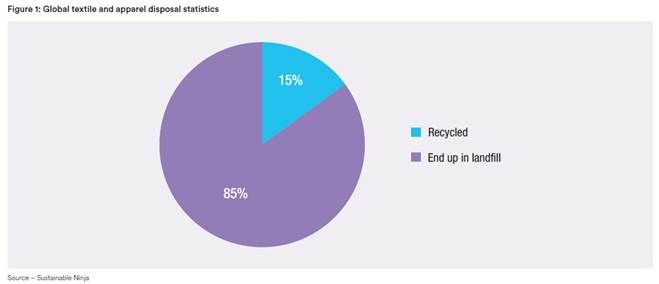
Textile production is responsible for 20 per cent of clean water pollution and is the third largest sector responsible for the pollution of land resources in the year 2020 according to the European Parliament. The industry is responsible for 7 per cent of the overall CO2 emissions. The industry emits around 1.7 billion tons of CO2 annually. Globally, the US and the EU are the only countries that are adopting laws binding to the entire textile and apparel value chain. The McKinsey’s State of Fashion Report 2024,’ the US and the EU are framing policies that are meant to increase the accountability of the companies involved in the apparel production via the policies like the Extended Producers Responsibility Act (EPR Act) and Third-Party certification for the process of production and the apparel production along with standardised matrices for pollution. Globally almost $500 billion is lost due to the underutilisation of apparel and failure to recycle clothes.
If looked at from the country perspective; US, EU, China, and India are some of the largest countries in terms of textiles. If seen from a country perspective, China the US, and the EU are some of the countries with the largest textile waste disposed of so far. China has disposed of around 20 million tons of waste followed by the US and the EU.
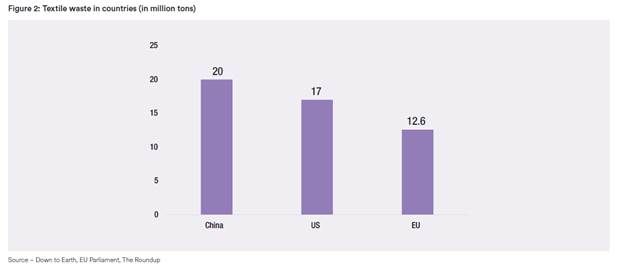
Country-Wise Stats
We know very well that the US and the EU are two of the largest importers of apparel and these countries are the ones which are trying to implement policies to ensure that the apparel that is imported as well as produced within their borders is more in the line of sustainability and the producers take the full responsibility of the apparel manufactured. For now, we consider two consumer countries US and the EU. Although the countries have their textile industry, these are some of the major importers of textile and apparel products from Asia. The countries considered here are the US and the EU.
Waste Statistics for The US and The Technological Scenario
The US is one of the largest consumers in the world when it comes to textiles and apparel. The country disposes of almost 17 million tons of textile waste. And out of it only 15 per cent is sent for recycling, followed by 19 per cent burned, and a majority 66 per cent of the apparel is sent to landfills. With a high return rate of apparel in the US the clothes that are disposed of in the US are made with technologies and materials that are difficult to recycle. The low recycling rate in the US is leading to the US Congress introducing the New York Fashion Act; to induce sustainability. It is important to ensure the implementation of the laws and stricter regulation of textile waste as it has increased by 76 per cent from the year 2000 to 2017.
 One of the most startling facts for a technologically developed country like the US is that the country still utilises recycling technologies on a small scale, and this is the small-scale use of fibre recycling technologies. Even though there is the availability of mechanical and chemical recycling of the fibres, the technological development has been only in terms of chemical recycling, and a significant fact about the same is the methods introduced so far are not made open for the consumers and therefore the methods are not used widely. Several startups have been established in the US but are still unable to bring the process to use less energy completely. The quality of the clothes being recycled and what is to be done to improve the quality of the same is to be found out through the process. To understand the condition better, it will be useful to take an example of one of the states of the US that is involved in the Textile Industry and the efforts taken to align to the sustainability goals.
One of the most startling facts for a technologically developed country like the US is that the country still utilises recycling technologies on a small scale, and this is the small-scale use of fibre recycling technologies. Even though there is the availability of mechanical and chemical recycling of the fibres, the technological development has been only in terms of chemical recycling, and a significant fact about the same is the methods introduced so far are not made open for the consumers and therefore the methods are not used widely. Several startups have been established in the US but are still unable to bring the process to use less energy completely. The quality of the clothes being recycled and what is to be done to improve the quality of the same is to be found out through the process. To understand the condition better, it will be useful to take an example of one of the states of the US that is involved in the Textile Industry and the efforts taken to align to the sustainability goals.
California
Being one of the top fashion capitals in the US, the state is also home to the sewing factories in the US, it is one of the first states in the US to implement the textile waste ban which mandates that households do not dispose of any textile items in the landfills or incinerators. Being one of the largest manufacturers in the US, the state has contributed almost 15 per cent to US manufacturing. The law is important to be implemented as according to the McKinsey Report, from 5,10,000 tons of apparel used by the people in California, only 5,000 clothes are recycled. This makes it barely just one per cent of all the clothes that are used in the state.
There is barely less than one per cent that goes to textile-to-textile recycling. The main issue with the upcycling of textiles is fewer firms adopt textile-to-textile recycling. Almost all the firms have adopted textile recycling on a pilot basis. The closed-loop recycling method has been encouraged to be adopted in almost all the states in the US. But considering California is important due to Los Angeles – the second fashion capital of the US. The issue of textile waste in California is an issue as it is a burning issue in the state. Although there are some steps taken to resolve the issue, the reach of the capacities and the companies is still low. There are 30 or so firms in California that work to recycle the companies’ textile waste.
California specifically has the largest concentration of garment workers in the US and therefore, with such prowess, the issue of textile waste becomes one of the harrowing issues for the state. So far, the state has seen very limited efforts, investments, and the reach of such technologies to the textile industries, and therefore there is a need to ensure that the clothes used, produced, consumed, and then further disposed of are fully recycled.
The textile waste statistics are harrowing. Being no different as compared to the other nations in the word, the amount of clothes recycled is less than one per cent as compared to the total textile waste disposed of. Yearly almost 6 per cent of the waste is incinerated of the total textile waste.
Almost 7,40,000 tons of used clothing is expected to be disposed of. And if went by the stats, almost 6,60,000 tons of textile waste may go to the landfills and the remaining 10 per cent is diverted to recycling.
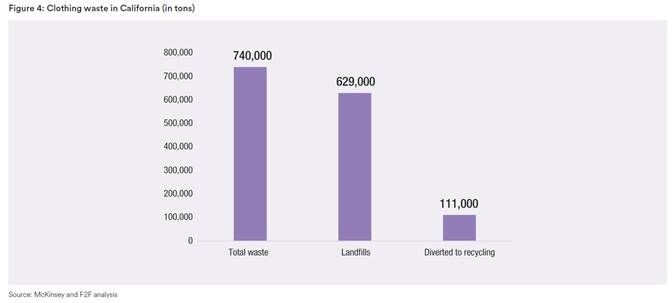
From the 1,10,000 tons of apparel diverted from the landfills in California, only about 5,000 tons are sent to actual recycling. This means a mere 5 per cent of the diverted waste is converted into apparel. This also means that the remaining is either sold out as second-hand clothes, exported to other countries, or downcycled. This shows the dire need to invest in recycling technologies. If one considers the consumer preferences for purchasing apparel made from different materials, only a mere 20 per cent of the households have given used clothing directly for recycling purposes. And the majority who donate the clothing, the system is hard as of now to track what happens to the clothing after it is donated.
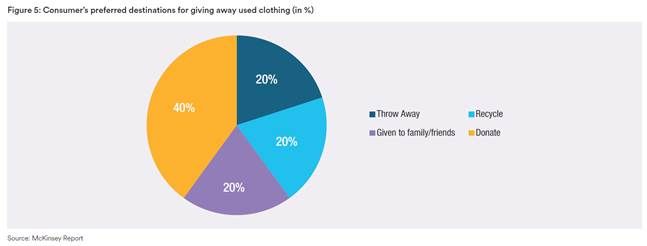
The same is the case for the kind of clothing that the consumers prefer. A survey taken by McKinsey revealed a high preference for clothing made from natural fibres like organic cotton and a mere 36 per cent for recycled clothes.
However, if a method of recycling for used and disposing of textiles is adopted, it will have a lot of benefits for the country, in terms of the social but also for the economy. Adopting a closed-loop method for the recycling of clothes will lead to the generation of jobs along with huge benefits in terms of the environment. There are multiple brands worldwide that have attempted to adopt on a pilot basis the circular method of recycling used apparel using the closed loop method. Although this is the case for the US, the same case persists in the other corners of the world. Take the EU for example.
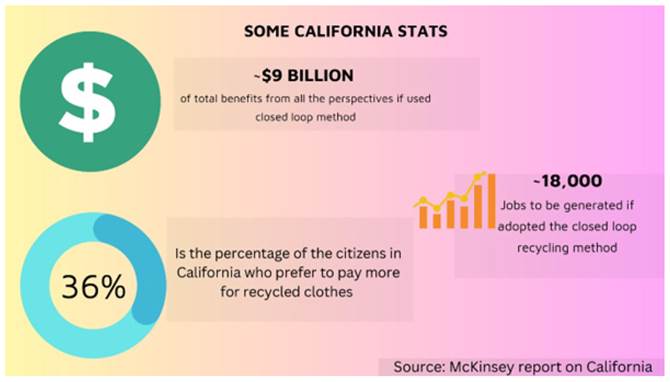
Australia
Being the world’s second-largest consumer of apparel in the world, even Australia exports a major chunk of the apparel to other countries as second-hand clothing. And the majority is sent to domestic recycling. The charitable groups in Australia receive around 12.1 kg of textiles per person. The charities must pay a hefty cost of sending the unused apparel to the landfills; and due to the lack of proper regulation on textile waste; the charities must educate the citizens to dispose of only those clothing materials that are in good condition for reuse or recycle.
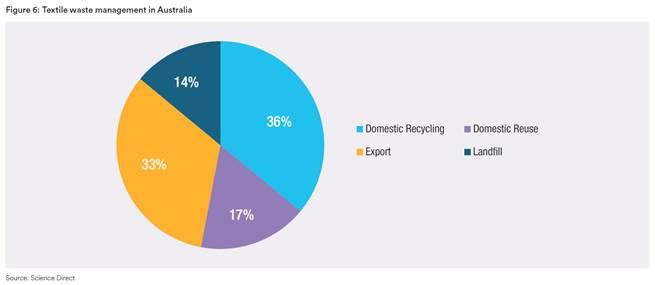
Australia is taking proactive steps to imbibe circularity in the value chain. There is a multistakeholder collaboration in the country; which led to initiatives like the Waste and Resources Action Programme (WRAP), Universities and charities to design an action plan to tackle the issue of the textile waste generated in the country by keeping a financial buffer to help manage the end of life cost of the product; by sharing the burden and helping to minimise the environmental and health impact of the product.
Apart from this, the country is also taking very basic steps towards imbibing sustainability like introducing the same in school, sustainable procurement, utilising sustainable practices in the workplace and including sustainability and innovation in the fashion and textile courses etc. Apart from this, the retailers are also doing their part by accepting clothes which are partially torn and used which helps to divert clothes from the landfills. A lot of fashion brands use the collected waste partially in the production of new garments. A lot of brands are aiming to increase the component of recycled materials in the production of apparel by the year 2030.
Initiatives like the SWOP clothing exchange shops, Suitcase rummage, Garage sale trail, and the Brisbane revive festivals showcase the discarded clothing in novel ways. Thus, although the country has fewer municipal collection infrastructure and regulatory regulations for textile waste management, the initiatives are helping the country to move towards a more sustainable future. The country still has to tackle issues like having a cost-effective method of collection of textiles, a proper law for textile waste collection and disposal, a waste collection law and proper government initiatives to ensure the continuous process of sustainable textile production and disposal.
The EU
The EU also has the same condition when it comes to clothing waste. EU generates around 12.6 million of textile waste every year and from those a mere 22 per cent is recycled or re-used and the remaining is either incinerated or is landfilled.
 According to a report from McKinsey, around 85 per cent of textile waste comes from post-consumer waste disposed by households. That is estimated to increase by the year 2030 if the same trend of fast fashion without any measures to tackle the problem of textile waste continues, thus proliferating the already existing problem into a crisis. The policy of the EU to tackle textile waste along with pro-active participation in promoting the adoption of textile waste recycling as the EU has been relying too much on exporting used clothing to African countries and some countries in Asia also has led to some environmental problems arising due to an improper infrastructure to handle the landfills.
According to a report from McKinsey, around 85 per cent of textile waste comes from post-consumer waste disposed by households. That is estimated to increase by the year 2030 if the same trend of fast fashion without any measures to tackle the problem of textile waste continues, thus proliferating the already existing problem into a crisis. The policy of the EU to tackle textile waste along with pro-active participation in promoting the adoption of textile waste recycling as the EU has been relying too much on exporting used clothing to African countries and some countries in Asia also has led to some environmental problems arising due to an improper infrastructure to handle the landfills.
The data from the McKinsey report indicates that 50 per cent of textile waste collected and sorted by textile collectors and sorters is sold in second-hand and international markets, making it the second largest revenue source after the EU second-hand markets. Notably, nearly 60 per cent of the total textiles/clothing collected and sorted are exported to second-hand markets within the EU.
Given these figures, it becomes crucial for the EU to champion recycling methods across all member countries. McKinsey’s report on the circular economy in Europe suggests that an initial investment of approximately $6.5 billion is necessary to effectively initiate circularity initiatives within the bloc. These initiatives would involve policies mandating producers to take responsibility for the apparel they manufacture.
Out of the second-hand clothing exported by the EU, almost 46 per cent of the used clothing gets exported to the African regions, and that itself is a major issue. With the obligation for all the textile waste to be collected separately in the EU by 2025, higher is the possibility that the textile waste will increase. Countries like France have tabled a ban in the Parliament to ban the exportation of second-hand apparel from the bloc to countries like Kenya, and Ghana as the exports are hurting the country’s ecological balance as well; along with stunting the growth of the domestic textile industries there.
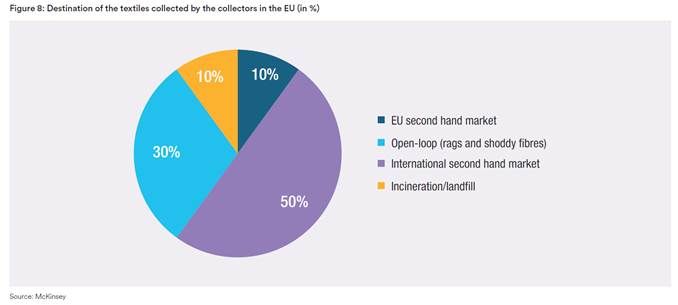
The figures given below give a rough scenario of the total exports of second-hand clothing from the EU to Kenya and Ghana. To Kenya, if looked at the overall exports of the EU to the countries have been reducing, although half of the same also can be attributed to the economic uncertainty which reduced the overall exports to other regions.
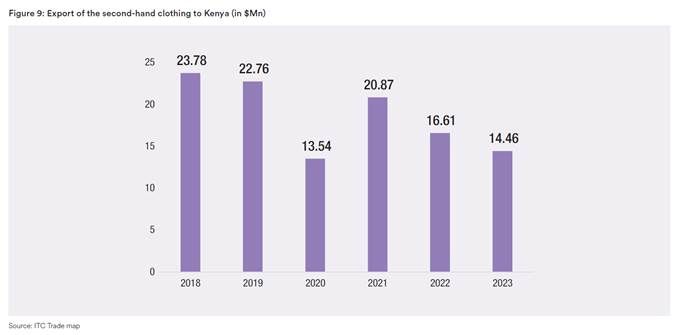
Similar challenges are evident in the export of second-hand apparel to countries like Ghana. While overall exports may be declining, the environmental impact on recipient nations remains substantial. In response, recent policy initiatives by the EU, such as the Extended Producer Responsibility Act and efforts to curtail the export of second-hand clothing to African countries, are poised to stimulate innovation in recycling technologies within the bloc itself.
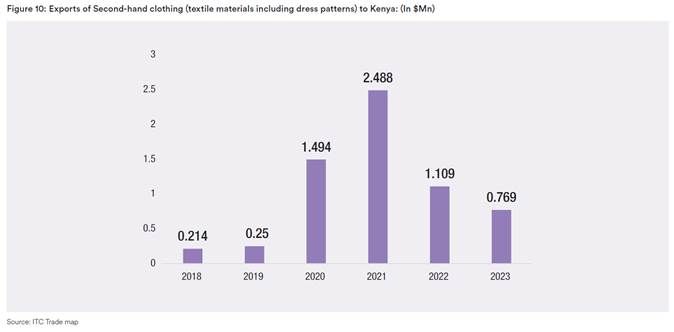
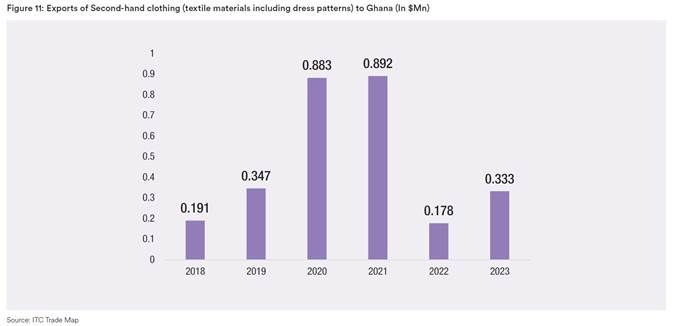
Conclusion
The discourse underscores the urgent need for a paradigm shift in waste management within the fashion and textile industries. Despite global awareness and occasional commitments, textile waste continues to inundate landfills, perpetuating environmental degradation. Initiatives in regions like the US, EU, and Australia offer glimpses of progress through circularity efforts, yet systemic challenges persist. Comprehensive policy frameworks, coupled with technological innovation and stakeholder collaboration, are imperative to mitigate the escalating environmental toll of textile waste worldwide. Only through concerted action can the industry transition towards a sustainable and circular future, ensuring the preservation of our planet for generations to come.








Comments